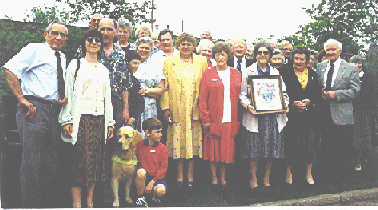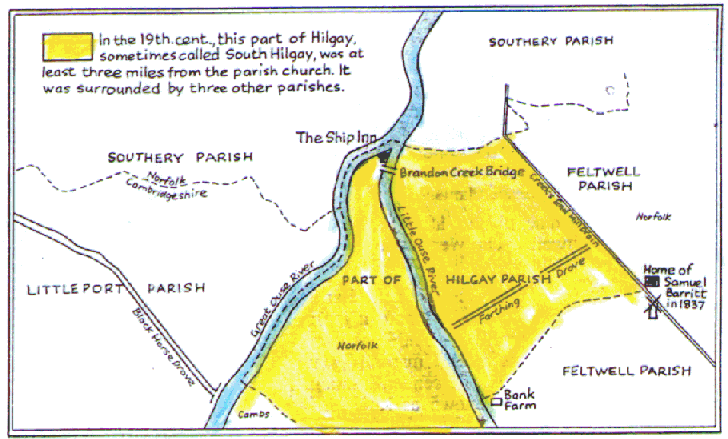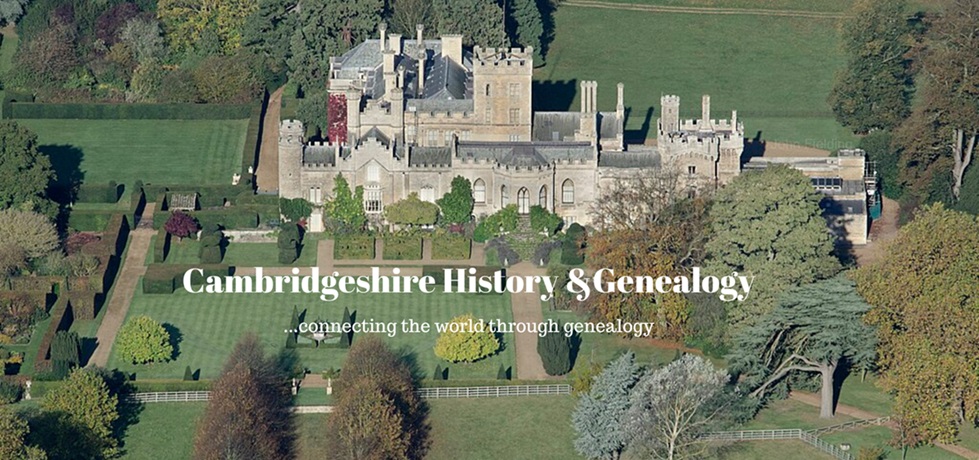The Barritts of the Fenlands - Page 1 |
Overview
For many years Ron Barritt, until his death a few years ago, traced the Barritt/Barrett line back to Samuel Barritt of Feltwell. At this point the line currently stops, Samuel being an elusive sole to trace. The Barritt/Barrett descendents hold an annual reunion in Ely in May of each year. The reunion in 1999 was the 15th and attended by 30 descendents.
 The Barritt Reunion 1st May 1999 - The Cutter Inn, Ely |
 The Barritt Reunion 2000 - Ely |
These pages are dedicate to the memory and work of Ron Barritt
and are kindly reproduced with the consent of his widow, Muriel.
If you have any information that will help continue Ron's work please contact
Barretts and Barritts
by Ron Barritt
This story begins seven weeks after the decisive Battle of Trafalgar in which a Norfolkman, Admiral Horatio Nelson, died. On Sunday, 8th December 1805, another Norfolkman, Samuel Barrett and his wife Mary, took their infant son John to All Saints Parish Church of Hilgay to be Baptised.
I've tried in vain to find out where Samuel was born, where he married Mary, her maiden name and where they lived in the Parish of Hilgay. I'm certain they lived close by The Ship Inn at Brandon Creek which is now reckoned to be in the Parish of Littleport in Cambridgeshire, whilst over the Little Ouse River it is Norfolk. However, 200 years ago this area was a detached part of the Parish of Hilgay, hence Samuel's infant being baptised 3 miles away at All Saints instead of the much nearer church of St. Mary, Southery.

The yellow area of the map shows the detached part of Hilgay where I think they lived. In 1805 Samuel was aged about 23 and Mary about 28, so possibly John was their first-born. Not anywhere in this area could I find any child of theirs younger than John. Samuel and Mary married in the early years of the 19th Century but as mentioned above, 1 could not find evidence of their marriage. In 1810 another son, later named Thomas, was born but then there was a period of sadness. On Monday 29th January 1810, Mary was buried at Hilgay aged 32, having obviously died in childbirth. Thomas was baptised at Hilgay just over a month later on Saturday 3rd March. He lived with his father and stepmother on Feltwell Fen until 1828 when he was buried at Feltwell, aged 20. There was more sadness for Samuel two years later when young John was buried at Hilgay on Tuesday, 3rd March 1812. By this time Samuel had moved into the Parish of Feltwell, on the fen there, had met the widow Mary Terrington and just over 3 months after burying John, Samuel and Mary weie married in the ancient Parish Church of St. Nicholas, Feltwell. The full entry of the marriage, on Monday 15th June, 1812, taken from the St. Nicholas general register is:
'Samuel Barrett of this Parish, Widower, and Mary Terrington of the Parish, widow, were married in this Church by Banns, this fifteenth day of June in the year One Thousand eight hundred and twelve, by me R. Stephenson, Curate.
This marriage was solemnized between us:
Sam'l Barritt, Mary X Turrington
In the presence of:
David Barns, Wm Graham'
The register of Banns shows they were published 31st May, 7th and 14th June 1812.
The Curate wrote Samuel's name as Barret, but Samuel was sufficiently literate to sign his own name and it clearly shows as Barritt. He was now aged 30 and at some stage in his life had been taught to write. For the rest of Samuel's life, in any document relevant to him, he spelt his name Barritt. His eldest son Robert by his second wife was also literate and in both his marriages he signed the marriage registers Rob't Barritt. Most of Robert's children and later generations regard their surname as Barritt, yet Samuel's other 3 sons, all of whom were illiterate, spelt their name Barrett, as do their descendants.

Almost exactly nine months after Samuel and Mary married, there was a double baptism at Feltwell. On Wednesday 17th March 1813 there are entries in the Baptism Register:
Robert Terrington Barret and Richard Barret, sons of Samuel and Mary Barret, labourer of Feltwell, baptised. I thought at first that Robert and Richard were twins but subsequent research shows that Robert was one year older than Richard and that he was born before his parents married. Hence the name Terrington appearing in the register. All Robert's descendants should therefore carry this name and for a time I considered being known as Ron Terrington Barritt, but this would involve changing too many documents.
In 1813, the year that Robert and Richard were baptised, the village of Feltwell became a Combined Parish. Since Norman times, when the village had 7 separate Manors, it was always divided into two Parishes: St. Nicholas and St. Mary. From 1813 the two churches were used for baptisms, marriages and burials on alternate years, so it is not possible to know which church was used for specific purposes in any one year. Only one register was used for the combined Parish and tlie Rector from 1st January 1813 was Rev. Henry Prichard. Samuel and Mary, hving out on Feltwell Fen, came within the Parish of St. Nicholas, which is why they married in that church just before the amalgamation took place.
In the next nine years Samuel and Mary had six more children including twins, William and Rebecca. Fourteen years later, on 24th August 1836. Samuel and possibly Mary, took their five youngest children six and a half miles across the fen to 6ne of the village churches to be baptised, including the twins William and Rebecca, already baptised in 1822. The other children were Sarah aged 12, Harriet aged 11 and Rachel aged 4. I have often wondered what that journey and the return would have been like, with Mother and Father leading their five children across the fen without roads. Passages across the fens, before roads were built, were called Droves which usually skirted the large fields or the numerous man-made waterways.
Fen soil is excellent for agriculture as it is pure peat many feet deep, resting on a clay underbase. It has been said that walking or working in the fens in winter meant wading through black mud and in the summer clouds of black dust would rise up, particularly in a dry, breezy period. In August 1836 it would have been summertime and hopefully the Barritt family made the arduous journey without mishap. I'm certain little Rachel would have needed some help. Samuel Barritt was now described in the baptism register as a farmer.
Parish Registers, Registrations, Census Returns
St. John Little Ouse and Brandon Bank
Sophia Attesley, wife of Robert Barritt
Richard and William, sons of Samuel and Mary Barritt
George, son of Samuel and Mary Barritt
Elijah, son of Robert and Sophia Barritt
Banyard, son of Robert and Sophia Barritt
John, son of Robert and Sophia Barritt
Ebenezer Barritt, son of Robert and Sophia Barritt
Thomas Barritt, youngest son of Robert and Sophia Barritt
George Barrett, son of George and Martha
James Barrett, son of George and Martha
Mary Ann Barritt, daughter of George and Martha
Rachel Barrett, daughter of George and Martha
Samuel Barrett, youngest son of George and Martha
© Ron Barritt - March 1995
Reference
Derivations of the name are Barrat, Barratt, Barrett, Barritt, Barrott. The first references found to include the name were Matthew Baret circa 1150-5 found in the 'Documents illustrative of the Social and Economic History of the Danelaw' for Lincolnshire; Robert Baratte 1165 in the Pipe Rolls for Nottinghamshire; JordanBarat 1185 in the 'Records of the Templars in the Twelfth Century' for Hertfordshire; Seman Barette 1207 in the Pipe Rolls Hampshire; William Barrette (Barat)1327 in the Subsidary Rolls for Essex. This is a difficult name. There seems no evidence for a derivation from Old German Beroald, Old French Beruad, as has been suggested. Old Norse B�r�r is found in Yorkshire and Lincolnshire in the Doomsday Book as Bared, Baret, but there is no proof of its continued use. The commonest form is Barat and this must be from Old French Barat, Medieval English Bar(r)at, Bar(r)et(te), which accounts for all forms. The original sense in Romanic seems to have been 'traffic, commerce, dealing' and in Medieval English 'trouble, distress' (circa 1230); 'deception, fraud' 1292; 'contention, strife' circa 1300, from any of which a nickname could arise. Occasionally we may have Old French barrette 'a cap, bonnet', as an occupation name, 'a maker of caps'.
Second Edition, published by Routledge & Kegan Paul, second edition, ISBN 0 7100 8106 5
For Barrett see Barratt, of which it is the far commoner form.
Barrat(t), nickname, 'commerce, chaffering' or 'trouble' or 'fraud' or 'contention, strife' Old French - all these meanings could lead to nicknames. But sometimes an occupational name 'cap-/bonnet-(maker)' Old French, a metonym.
